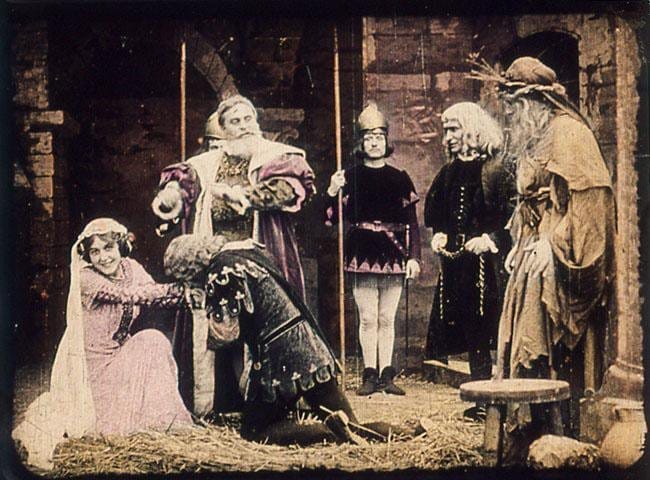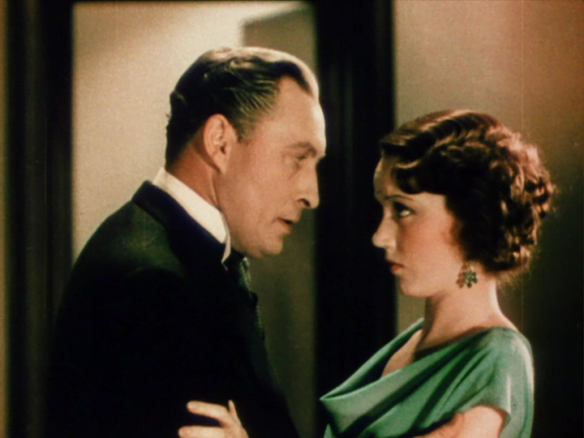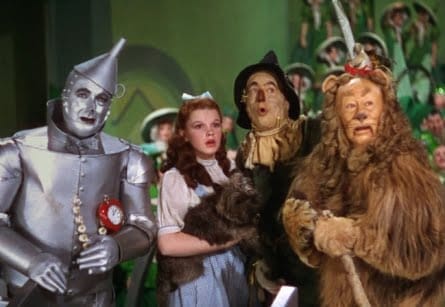What is “Color”?
This question baffled people for ages. Aristotle had theories based on the four elements Earth, Wind, Fire, and Water. But it wasn’t until 1666 when a young Isaac Newton first began experimenting with optics that we began to think of color as a function of light.

Color is our psychological reaction to a very narrow band of electromagnetic radiation which we call light – from the red on the lower end of the spectrum through orange, yellow, green, blue, indigo, and violet at the high end. Through his experiments, Isaac Newton discovered that you could combine all the colors of light to create what looked like white light. From his experiments he created the world’s first color circle, using seven colors similar to the notes of a musical scale.
But you didn’t need all the colors to create white light or any color light. It turns out you only need three primary colors. This trichromatic theory was first put forward by Thomas Young and Herman vonn Helmholtz in 1802 – they postulated that the human retina was made of cones that were responsive to only three colors of light – red, yellow, and blue.
Every color that we perceive as the brain’s reaction to the combination of stimuli of those three primary colors. But the Young-Helmholtz Theory (though mostly correct) was based on scientific reasoning, not experimental evidence. Their theory would be refined in the 1850s by one of the greatest scientists of all time James Clerk Maxwell. Maxwell was very much interested in color.
In his 1855 paper, Experiments on Colour, Maxwell used spinning tops to demonstrate the validity of the Young Helmholtz theory, refining the primary colors to Red, Green, and Blue which he could mix in various amounts to achieve all the perceivable colors.
In 1861, with the help of Thomas Sutton, the inventor of the Single Lens Reflex camera or SLR, Maxwell applied his theory to photography, shooting a tartan ribbon with a black and white camera three times, once using a red filter, a green filter, and a blue filter.
Combining the color separations back together, Maxwell and Sutton created the world’s very first permanent color photograph and the basis for all color photography to come. Though Maxwell had demonstrated the principles of color photography in 1861, it would take a long time before capturing naturalistic colors could be employed in the motion picture industry. Part of the problem was film stock was more sensitive to parts of the spectrum than others… But that didn’t stop the early filmmakers from adding color back in after the fact.
Hand Tinting was a widely practiced technique of painting color onto the film itself. During the early days of motion pictures, where features lasted only 10 minutes or so, it was economically viable – in fact, Georges Melies employed 21 women to hand tint his films frame by frame.
As the demand for film became greater and greater, Charles Pathe mechanized the process of coloring film in France using a stencil process he called Pathecolor. By 1910, Pathe employed 400 women in his factory and the process was used throughout Europe.

Coming into the 1920s, as the film became an international mass media industry, even stencils could not meet the demands of production. Filmmakers began using bath processes to tint and tone their films. Tinting involved putting the black and white film in a bath of dye – this would turn the entire frame a particular color. Toning on the other hand only colored the dark parts of the frame by chemically converting the silver in the film to colored silver salts.
Some filmmakers like D.W. Griffith used tinting and toning to enhance the emotional elements of the film but oftentimes, labs would just apply colored dyes based on the scene location or even just randomly. In the 1920s, 80 to 90 percent of all American films were using some form of tinting or toning in at least some scenes. But tinting and toning caused problems once sound was introduced in 1927. The sound was recorded as an optical track that ran alongside the film, tints and tones would mess up this track. Pre-tinted film stock was created to solve this problem but it saw little use as more naturalistic ways of creating color were starting to become popular.
There are two methods of creating color: The Additive system is where primary colored lights are added together – when equally mixed, they create white light. The other system is the Subtractive system where primary colors are subtracted from white light to create colors and when all added together to create black.

The first major venture into capturing color naturally in motion pictures came in 1908 with Charles Urban and the Natural Color Kine-MATograph Company in England to produce and distribute Kinemacolor films. The Kinemacolor system, invented by George Albert Smith was a sequential two-color additive process that came about after years of experimentation, In the camera, one frame would be captured with a red filter and the next frame with a green filter and back and forth. When played back with a projector with a red-green filter flywheel, the projected red and green image sequentially would “add” together because of our persistence of vision. The result was a surprisingly good color image despite being only a two-color system. Since only red and green filters were used, blue skies were impossible to reproduce. This would spell the downfall of Kinemacolor.

The first truly successful color system would have to be subtractive and it would come in the two-strip subtractive Technicolor. The Technicolor company was founded by Dr. Herbert T. Kalmus, Dr. Daniel F. Comstock, and W. Burton Wescott in 1915 to exploit a two-color additive process. Their first film was an utter failure- so they changed direction and started working on a two-color subtractive process. The new process patented in 1922 used a beam-splitting camera that split the light coming into the camera onto two film stocks – one which was ultimately dyed red-orange and the other which was dyed blue-green. The resulting positive color images would be cemented together for a final color positive image which could be played back in the same projector as a black and white film.

The first Technicolor 2 strip subtractive feature film was The Toll of the Sea in 1922. The Toll of the Sear grossed over $250,000. Two strip technicolor was a hit. In 1928, Technicolor refined the process with a step called Imbibition or IB: combining the color separations onto a third black gelatin-coated film which gave technicolor a richer look. Technicolor was in the right place at the right time. As films evolved from the silent to sound era, musicals were a big genre and perfectly suited to the color. In 1930 Technicolor was under contract for thirty-six major releases. But just two years later in 1932, the production of Technicolor films had all but ended. Audiences were tired of seeing the poor registration of the two-color process -which was not a flaw of the process but caused by untrained cameramen. Also, Eastman’s panchromatic film stock, black and white film which was sensitive to a much wider part of the visible spectrum, produced beautiful looking black and white images under normal incandescent light. This was much cheaper to use than the arc lights needed for the Technicolor two strip.
But Technicolor wasn’t out for long. In 1932, they perfected the three-strip Technicolor system. Using a beam splitter they captured light onto three pieces of film – Green onto its strip and blue and red onto a bipacked strip. This three-strip process was technically superior to anything that had come before it but it was really expensive – the cameras costing upwards of $30,000 apiece. Technicolor learned a valuable lesson from the boom and bust of two strip process and maintained an iron fist over quality control on the production of Technicolor film. To make a Technicolor film, you needed a Technicolor cameraman, have the film processed and printed by Technicolor, and accept a technicolor consultant who would make sure your art direction had an acceptable color palette.
Hollywood majors were hesitant to jump on board with this expensive process especially after the failure of the two strip. So Technicolor offered the process to a small upstart – Walt Disney for his “Silly Symphony” cartoon series. Flowers and Trees (1932) and The Three Little Pigs (1933) -were both huge successes and even went on to win Oscars for best animated short. For live-action, small upstart Pioneer Films produced Technicolor’s first feature film: Beck Sharp which had great buzz but was ultimately a failure. Throughout the 30s the studios cautiously tested the Technicolor waters – David O. Selznick’s independent studio produced the first successful Technicolor feature with Garden of Allah in 1936. In 1938, Warner Bros. would release one of the best showcases of Technicolor’s capability with The Adventures of Robin Hood 1938 which won three Academy Awards for its aesthetic use of color.
And then came 1939 – considered the greatest year in the golden era of studio-controlled Hollywood, 1939 was also a great year for Technicolor. The Wizard of Oz demonstrated the incredible richness of Technicolor in creating a magical land of Oz. But it was Gone with the Wind that first put to use the company’s new faster fine-grain film stock-a major technological breakthrough that reduced the light needed by 50%.

Two years later in 1941, Technicolor introduced the mono pack – combining the three separations into one single roll of film that could be loaded in conventional cameras – great for location shooting. Technicolor had come back after the failure of 2 strip and now was on top of their game and doing what Charles Urban could only hope to do with Kinemacolor… hold a virtual monopoly over color film production.
Eastman color Takes Over Technicolor and its supplier Eastman Kodak controlled 90% of the color film market. Even though there were other rival processes like Cinecolor and Trucolor, the United States Justice department saw this as a problem and filed an anti-trust civil suit in 1947. In 1950, a court decree forced Technicolor to make available certain cameras to small independent companies on a first come first serve basis. But this decree didn’t bring an end to Technicolor’s power. What would break the monopoly was a new kind of film stock – Eastmancolor.
Eastmancolor was based on the German Agfacolor process developed in 1936. Similar to the Technicolor mono pack that sandwiched three-color film separations in a single roll, Agfacolor was used as a crown jewel in Nazi Propaganda Machine. After the end of World War II, the patents were released and the process was adopted all over the world, becoming Sovcolor in the USSR and Fujicolor in Japan. But it was Eastman’s refinement of Agfacolor that made it popular. Using automatic color masking and released in 1950, Eastmancolor was relatively cheap, didn’t require specialized lights or lab processes, and would work in conventional motion film cameras. Eastmancolor would win an Academy Award in 1952 and within two years, the three-strip Technicolor process was all but dead.
Eastman color film stock took over and has since come to be known by the names of the studios that paid to use it like Warnercolor and Metrocolor or by the labs that process the film such as Deluxe and Movielab. Though the richness of technicolor had started the move of the film towards color, it was the ease and cost-effectiveness of Eastmancolor that sustained the growth of color so that by 1967 virtually all major features being made were shot in color. Even Technicolor ultimately switched over to the Eastmancolor process in 1975 selling off their imbibition dye process to the Chinese.

There was one major problem with Eastmancolor film and it would not rear its ugly head for at least a decade… Eastmancolor was not stable and it tended to fade and fade much faster than other techniques – as quickly as 5 years if not stored properly. This would be a major issue in film preservation in the years to follow. In 1980 Martin Scorsese lead a campaign to push Eastman to develop the low fade archival film which they did, but film preservation would continue to be an ongoing problem.
Digital Color Advancement to the color of films can come from all sorts of bizarre places. In 1985 media mogul Ted Turner set out to “colorize” a catalog of studio-era black and white titles he had acquired during his brief ownership of MGM/UA. Using digital manipulation, the films were scanned and colored frame by frame in sort of the electronic version of George Miles hand-tinting shops. The colorization of old black and white films was a controversial move with Turner himself half-jokingly stating he would not stop until he colorized Citizen Kane. Just three weeks before he died, Orson Welles who had a clause in his contract saying Kane could not be edited without his permission, told a friend, “Don’t let Ted Turner deface my movie with his crayons” – Citizen Kane was spared.
But Turner’s colorization got filmmakers thinking about the possibilities of selective color manipulation. In the 1990s, many filmmakers explored different lab processes such as bleach bypass to create unique film tones. In the 1990s and into the 2000s, computers had become powerful enough to handle entire films. Digital intermediaries – a process of scanning a film frame by frame into a computer to be digitally manipulated – open the doors to all sorts of new color treatment possibilities. The first film to get the digital intermediary treatment for the entire film was The Coen Brother’s O Brother Where Art Thou – in 2001. Cinematographer Roger Deakins worked for 11 weeks toning down the lush green summer foliage to achieve a dusty golden desaturated look.

As our filmmaking post-production tools continue to move into the digital realm, the creative possibilities for color manipulation are endless. But perhaps just as important, our modern digital tools can also give us some weapons in the fight for film preservation. We have a much better capability to restore the fading prints of films past, preserving our cultural heritage for future generations.
In recent years, artificial intelligence (AI) has been making its way into many aspects of the film industry, from production and post-production to marketing and distribution. One area in which AI is proving to be especially useful is color grading. This process involves adjusting a film’s or video’s colors to make it look more visually appealing and give it a certain feel or atmosphere. AI-driven color grading is becoming increasingly popular, as it can save filmmakers time, money, and energy. The traditional method of color grading involves manually adjusting the colors of each frame of a film or video, which is time-consuming and labor-intensive. AI-driven color grading, on the other hand, uses algorithms to automate the process. It works by analyzing the colors in each frame and then making adjustments accordingly. This allows for more precise and accurate results than can be achieved with manual color grading.
Furthermore, AI-driven color grading can save filmmakers time and money. Automating the process eliminates the need for a colorist, which can be expensive. Additionally, AI-driven color grading can be used to achieve more creative results. For example, it can be used to create stylized looks, such as a vintage or dreamy look. Additionally, AI-driven color grading can be used to match colors between multiple shots or scenes. This can be particularly useful for films that use different cameras or lenses. AI-driven color grading is also becoming increasingly popular in the marketing and distribution of films and videos. Many streaming services, such as Netflix and Hulu, use AI to analyze a film’s or video’s colors and then optimize it for each platform. This ensures that viewers have the best possible viewing experience. Overall, AI-driven color grading is proving to be a powerful tool for filmmakers and video producers. It can save them time, money, and energy while allowing for more creative and precise results. As AI technology continues to evolve, it will likely become even more useful in the film industry.